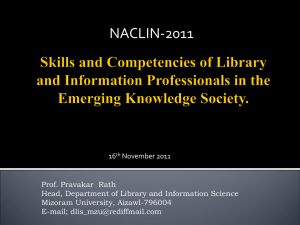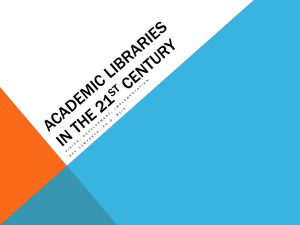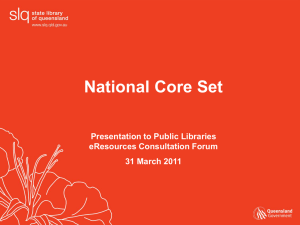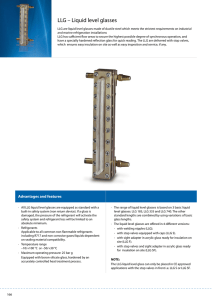The learning institution maturity model: A self
advertisement
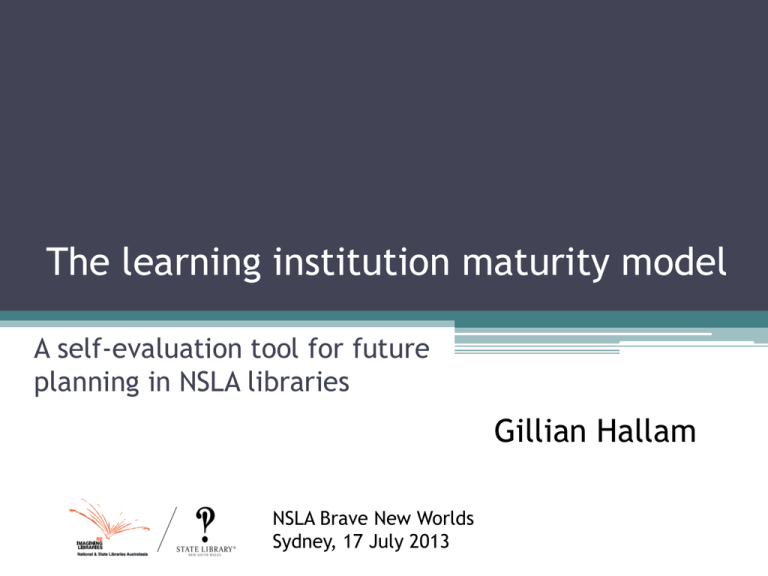
The learning institution maturity model A self-evaluation tool for future planning in NSLA libraries Gillian Hallam NSLA Brave New Worlds Sydney, 17 July 2013 Overview: The learning institution maturity model • Who? NSLA Literacy and Learning Group (LLG) • Why? Background to the project • What? The project brief • How? What did we do? • What did we end up with? • What can we do with it? Background to the Maturity Model project • Late 2010: NSLA Literacy and Learning Working Group (LLG) established • May 2011: Project initiation workshop to explore the issues: ▫ Society does not have a ‘habit of learning’ ▫ Society thinks that ‘learning’ only happens in a formal learning environment ▫ Low literacy leads to low participation in society • How might NSLA libraries make a difference? The LLG’s focus • The central role of libraries: helping people… …to learn …to develop the skills to engage with knowledge and ideas …to participate actively in society • July 2012: Position statement on literacy and learning LLG position statement • Literacy is “a skill that includes not only the individual ability to decode and encode in a medium, but also the social ability to use the medium effectively with others” (Rheingold, 2012) • NSLA libraries are well positioned to bring learning networks together, acting as catalysts for dynamic community enterprise • The LLG’s work combines: ▫ Advocacy: promoting the role of libraries in formal and informal education ▫ Development of organisational capability as learning organisations ▫ Best practice for library programs and partnerships Issues for LLG • How to recognise and articulate these elements: ▫ The ‘role of libraries in learning’ ▫ ‘Organisational capability’ as a ‘learning institution’ ▫ ‘Best practice’ programs and partnerships • Diversity across the members of NSLA ▫ Need to understand the continuum of development ▫ To visualise the potential pathways to maturity ▫ To formulate strategies for evaluating literacy and learning programs • Formalised as a work package document to create a ‘maturity model’ The project brief • A self-evaluation matrix to enable libraries to assess their perceived stage of maturity as ‘learning institutions’ ▫ The delivery of literacy and learning programs for constituent communities ▫ Constantly evolving organisational understanding and practice of the power of learning • To allow for peer review ▫ Critical friends ▫ Formal evaluation of specific programs • A tool for shared understanding about: ▫ Where we are now ▫ Where we are hoping to go • To lead to productive outcomes in terms of developing capabilities that are identified and valued by ▫ Our staff – the ‘internal’ perspective ▫ Our communities – the ‘external’ perspective An iterative process • Literature review ▫ Learning organisations ▫ Maturity models ▫ Measurement tools • Senge’s five disciplines (Senge, 1990, 2006) • INVEST model (Pearn et al, 1997) • Iterations of the maturity framework – mainly the ‘internal’ organisational perspective • Essential to have the ‘external’ community lens Senge – five disciplines ▫ ▫ ▫ ▫ ▫ • • • • Personal mastery Mental models Shared vision Team learning Systems thinking People are the active force of the organisation Collective vision & common aspirations Team learning to achieve the goals All elements need to be interconnected INVEST model (Pearn et al, 1997) • Six factors ▫ ▫ ▫ ▫ ▫ ▫ Inspired learners Nurturing culture Vision for the future Enhanced learning Supportive management Transforming structures • Strong focus on: ▫ The enhancers and support mechanisms that facilitate sustained continuous learning ▫ The inhibitors or blocks to learning that need to be identified and removed What sort of framework • • • • • Five-level framework? Four-level framework? Australian Professional Standards for Teachers? Individual – group – organisational levels? The bifocal lens: internal and external perspectives? ‘There is no right model’ ‘There is no cookbook approach’ ‘No magic bullets for building learning organisations: no formulas, no three steps, no seven ways… (Senge, 2006, p.283) LLG activities • • • • • • • • Draft the model Conference calls Review and refine the draft Skype meetings More reviewing and refining Face-to-face discussions Review and refine further Workshop in Brisbane Distillation in Brisbane • Concerns over blurred boundaries between the elements in the model ▫ 6 elements were reduced to 3 elements Learning and learners Vision and culture Management and structure • Different ideas about the nomenclature for the stages in the matrix ▫ Use the dimensions of higher learning Starting Knowing Doing Being • Working through the internal and external lenses A closer look at Learning and learners: the internal lens Learning and learners: the external lens Where we are now? Participatory action research model Image: www.regional.org.au/au/apen/2003/non_refereed/106maya.htm Current activities • Introducing the matrix to the NSLA member libraries • Each member of the LLG will trial the model in some way in their organisation ▫ At an individual or a team level ▫ Different areas of the library may be at different levels of maturity • Need to determine how to use the model ▫ ▫ ▫ ▫ How to apply the concepts – a diagnostic tool? How to monitor and evaluate its use? How to share results? Critical friends as part of the peer review process • LLG meeting tomorrow • International discussions at IFLA (19 Aug 2013) • Further discussions at QUT symposium (1 Nov 2013) Ultimate goal • To help individuals, their colleagues, managers and the community contribute to, sustain and benefit from libraries as learning organisations • To help each individual understand the contribution they can – and do – make to achieving the shared vision for the organisation • To ensure that staff – and clients “are engaged and accountable; they appreciate change; accept challenge; are able to develop new skills; and are committed to the organization’s vision and values” (Giesecke & McIntyre, 2004, p.55) Summary • Creating the matrix was a complex task: ▫ To adapt a multi-layered concept of a learning organisation – predominantly in the business sector - for the library environment ▫ To distil this into a ‘simple, elegant, logical and memorable framework’ • Iterative development of the maturity framework actually models the concept of the evolving learning organisation • The maturity model promises to be a valuable tool in this brave new world of literacy and learning Questions or comments… Contact me: g.hallam@qut.edu.au References • Giesecke, J. & McNeil, B. (2004). Transitioning to the learning organization. Library Trends, 53(1), 54-67. • NSLA (2012) Position statement on literacy and learning. www.nsla.org.au/publication/position-statement-literacyand-learning • Pearn, M., Roderick, C. & Mulrooney, C. (1995). Learning organizations in practice. London: McGraw-Hill. • Rheingold, H. (2012). Syllabus: Social media literacies. MIT Press. http://mitpress.mit.edu/files/rheingoldsyllabus.pdf • Senge, P. (1990). The fifth discipline: The art and practice of the learning organization. New York: Doubleday. • Senge (2006). The fifth discipline: The art and practice of the learning organization (Rev.ed.). Milsons Point, NSW: Random House.
